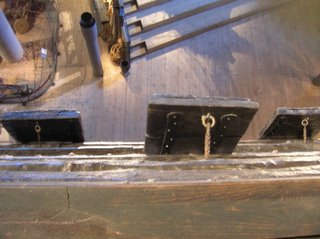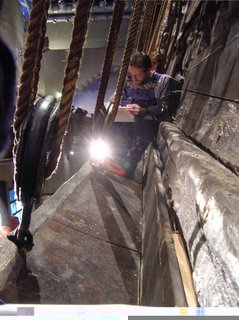Plucking Planks...
Well, this week has just about topped them all; I’ve spent the last several days in a harness hanging off the side of the Vasa removing planks and documenting the ship’s frames. Few things can even aspire to compare…

The whole project began with this pinrail (the horizontal timber with the coil of line hung on it). The pinrail is not original, but was made based on fragments of the original fitting found in that location—a piece deteriorated beyond recognition. Recently, however, our rigging expert has been growing increasingly doubtful as to whether there was ever a pinrail there in the first place. An original pinrail already exists just above it and the ship’s rig does not require any additional pins in this area. To solve the mystery he called upon the ‘Vasaenheten Forensic Unit.’ This group, dedicated to fighting crimes against the historical record, is currently composed of two researchers (Fred and I) and a pair of full-time handymen (Ova and Niklas).
As our world-class professional in the study of ship design and nautical archeology, Fred led the investigation. To unearth the truth about what kind of fitting was mounted in the location of the allegedly fraudulent pinrail, Fred decided to start with collecting evidence about the original fastenings for the unidentified fitting.
Inspecting the 378 year-old fastenings first required the removal of several sculptures and planks from Vasa’s starboard bulwark (on the right behind the rigging). So, the Vasaenheten Forensic Team suited up in our blue workmans’ overalls, put on some heavy safety harnesses, and piled over the rail.
Here Ova and Niklas are suiting up in harnesses while Fred--two steps ahead of them--is flopping over the rail. Once outboard and standing on the narrow chainwale, the tools are passed through and work begins to unbolt the several heavy, oak sculptures and the pine planks masking the fastenings of interest to us.
Remember that hopping over the rail onto the broad sides of this ship is not recommended for those with a fear of heights. If you recall from the Vasa Tour posting, this point abeam of the mainmast—and well below the lofty poopdeck--is still a good 55 feet above the shiphall floor (so don’t drop any tools!)
Niklas loosening the bolts attaching a scultpure to Vasa's exterior.
It took most of an afternoon to do the removal work and because this work was done during museum hours, we heard a few horrified visitors ask their guides, “Why are those guys tearing off pieces of the ship?” Of course they got a diplomatic reply about how it was research work and the few planks being temporarily removed were not originals anyway--to which Fred could not resist adding, “We’re not original either!” The point hardly needed to be made as Niklas straightened up to casually answer his cell phone out there on the chainwale, almost as if to emphasize the four century temporal gap.
 The preparatory work done, the handymen of Vasaenheten Forensic Unit came back aboard (over the rail or through the 3-pounder gunport in Niklas’ case). Note the removed sculptures laid out on the deck on the right--my goodness those are heavy!
The preparatory work done, the handymen of Vasaenheten Forensic Unit came back aboard (over the rail or through the 3-pounder gunport in Niklas’ case). Note the removed sculptures laid out on the deck on the right--my goodness those are heavy!
Vasa's side laid open...well, a small part of it anyway. Note the missing planks and exposed frames behind the rigging that were not visible in the above photo of this part of the ship.
 Next, the researchers (Fred & I) set to work examining, documenting, and analyzing the now-exposed bulwark frames for traces of long-gone fastenings. THey were masked under layers of PEG and hidden in the smooth curves of the current-worn joggles (bevels) of the vertical frames. Others were faintly visible in the heavily eroded planking. This photo looking aloft shows the rigging in the upper left leading to the maintop.
Next, the researchers (Fred & I) set to work examining, documenting, and analyzing the now-exposed bulwark frames for traces of long-gone fastenings. THey were masked under layers of PEG and hidden in the smooth curves of the current-worn joggles (bevels) of the vertical frames. Others were faintly visible in the heavily eroded planking. This photo looking aloft shows the rigging in the upper left leading to the maintop.
Fortunately we did have the chainwale (the wooden platform holding the shrouds out away from the gunwale) to stand on while we worked, but it only afforded us a slim ledge for solid footing on the side of that great ship.

Every detail of each of the vertical frames was carefully noted in well-measured sketches of the exposed surface. We recorded every contour, nail hole, and break in the aged wood. What did we find? Well, analysis of the ship's frames revealed that as our rigger suspected, Vasa never had a pinrail in this location. The bolt holes in the frames were not positioned correctly to take the load of a pinrail. Instead, the pattern of bolt holes was a textbook example of a mounting for a large wooden cleat. This possibiltity is much more in tune with rigging practices of the time and the needs of Vasa's rig--as best as we can understand it from a distance of 400 years. All that remain now in this case is to compare the findings to the decayed piece of original wood lying in the museum's artifact storage and see if the mountings line up and if its dimensions support the 'cleat theory'.

So, another day's work for Vasaenheten Forensic Unit has come to an end. Despite the hard work, we had a heck of a lot of fun. Not only were we playing with tools on the side of a huge warship, but we also got to spend hours in a surreal existence somewhere between being adventurous ten year-olds (best exemplified by the way Fred sat with his legs dangling over the ship’s side) and serious scholars documenting a one-of-a-kind archeological artifact. Personally, I find that mix to be a good recipe for an ideal career in any field...

1 Comments:
karen millen uk, ugg,uggs,uggs canada, ugg,ugg australia,ugg italia, pandora uk, canada goose, swarovski, louis vuitton, canada goose, nike air max, moncler uk, juicy couture outlet, moncler outlet, canada goose outlet, moncler outlet, canada goose, lancel, thomas sabo, pandora jewelry, gucci, louis vuitton, barbour, converse, moncler, moncler, replica watches, pandora jewelry, pandora charms, vans, montre pas cher, ugg uk, doke gabbana, supra shoes, hollister, canada goose outlet, louis vuitton, ray ban, ugg, links of london, converse outlet, coach outlet, canada goose uk, moncler, moncler, juicy couture outlet, canada goose outlet, louis vuitton, louis vuitton, toms shoes, canada goose jackets, barbour uk, marc jacobs, swarovski crystal,
Post a Comment
<< Home